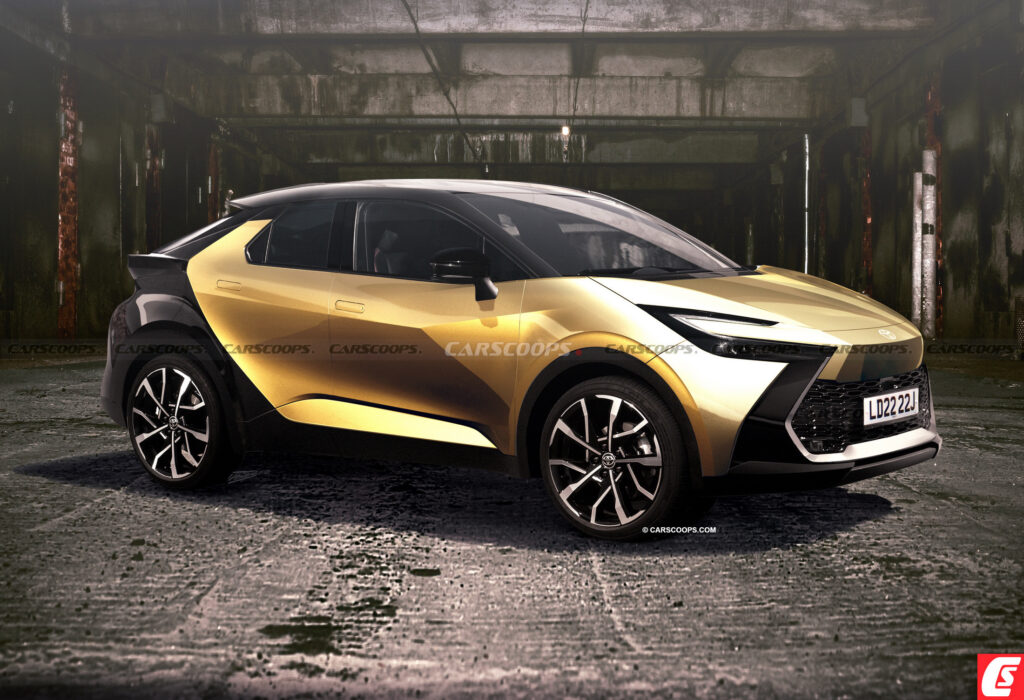A second generation of the Toyota C-HR subcompact SUV is around the corner and we have the scoop on it with all the juicy details
June 11, 2023 at 12:34

This article includes speculative illustrations that are not related to or endorsed by Toyota.
It’s hard to believe the current C-HR has been available on the market since late 2016. The pint-sized crossover from Japan has aged pretty well, amassing a cult following of loyal owners lured by its distinctive design and compact proportions.
Sadly, Toyota has made the decision to cull the C-HR crossover in North America in favor of the slightly larger Corolla Cross, which shares the same wheelbase length of 103.9 inches (2,640 mm). However, the rest of the world can look forward to a second-generation C-HR. By analyzing the recent patent leaks and high-quality spy photography, we have illustrated the next C-HR’s exciting and edgy new design, delving into all the available information we have in our hands prior to its anticipated debut.
Daring To Be Different
advertisement scroll to continue

Arguably, the outgoing C-HR was a mic drop moment, heralding a radical new design direction for a company that always played safe. Today, the Japanese automaker pushes the style envelope further so their vehicles stand out from the mainstream masses and the impending onslaught of Chinese offerings.
At a first glance, the new C-HR almost mirrors Toyota’s 2022 Prologue Concept, featuring similar proportions, silhouette, and glasshouse design, including the distinctive, albeit comically small, rear doors. Notably, the 2024 C-HR showcases a bold and radical front-end design, with c-clamp LED headlamps that carry more than a passing resemblance to the well-received 2023 Prius.
More: 2024 Toyota C-HR Shows Its Slim Taillights Prior To June 26 Debut
The sheetmetal surfacing has been finely tweaked, with dynamic contours and triangular creases. The designers have placed a significant emphasis on contrasting body panels, including blacked-out elements on the lower sill, front-end graphic, roof, and rear section. While this striking contrast undoubtedly captures attention, it raises questions about the potential manufacturing complexity involved in achieving such intricate details.
A Smarter Outlook
Moving to the interior, the new C-HR will offer a premium and technology-driven cabin with improvements to occupant space, comfort and convenience. There’s a strong BMW vibe with its driver-centric cockpit design and the way the dashboard wraps around the touchscreen interface. A row of piano key buttons serves heating, ventilation and air-conditioning (HVAC) duty, whilst a narrow center console ridge houses the e-brake, drive mode selector and gear lever.
More: Everything We Know About The 2025 Toyota Land Cruiser Prado That May Come To U.S.
The new C-HR will be equipped with several key features, including a 12.3-inch touchscreen infotainment system that supports wireless Apple CarPlay and Android Auto, allowing for seamless smartphone integration. The vehicle also boasts over-the-air (OTA) update capabilities, ensuring that software and system enhancements can be conveniently implemented.
Other notable features will include a digital key entry system, a digital instrument cluster, and a head-up display, all contributing to a more advanced and user-friendly driving experience. Additionally, the C-HR should come standard with the Toyota Safety Sense 3.0 suite, providing a range of advanced driver-assistance systems such as pre-collision warning, pedestrian detection, lane departure warning, steering assist, and dynamic cruise control.
Greener Credentials

The Japanese automotive powerhouse has locked in various powertrain options for the new C-HR catering to different preferences and environmental considerations. As it confirmed last year, these will include hybrid and plug-in hybrid variants, whilst a fully battery-electric model is believed to debut later.
Given its shared TNGA-C platform architecture with the latest Prius, it is highly likely that both hybrid powertrains in the new C-HR will be borrowed from the former’s lineup, allowing for economies of scale and cost reductions. For reference, the standard configuration of the 2023 Prius features a 2.0-liter four-cylinder engine combined with a new lithium-ion battery pack, resulting in a robust power output of 194 horsepower (145 kW / 197 PS).
More: A Look At 10 New Volkswagen EVs Coming By 2026
For those seeking more performance and the convenience of home charging, there will be a PHEV option. In the Prius, this powertrain delivers 220 horsepower (164 kW / 223 PS), providing a substantial 40 hp increase compared to the current C-HR Hybrid. This variant should offer a swifter acceleration from 0 to 60 mph (96 km/h) in under 7 seconds. Additionally, owners who opt for this configuration can enjoy an EV mode range of up to 38 miles (61 km), allowing for extended electric driving capabilities before relying on the internal combustion engine.
Rivals and Reveal
The all-new C-HR will enter a hotly-contested segment, facing strong rivals such as Honda’s polarizing new HR-V, Ford’s stylish Puma, Hyundai’s popular Kona, Mazda’s sporty CX-30, Kia’s versatile Seltos, Volkswagen’s compact T-Cross, and Nissan’s eye-catching Juke. With a range of compelling options available, customers in this segment will have a variety of choices to suit their preferences and needs.
Toyota has confirmed that the new C-HR will make its world premiere on June 26, with sales tipped to kick off in the fourth quarter – so save the date.




